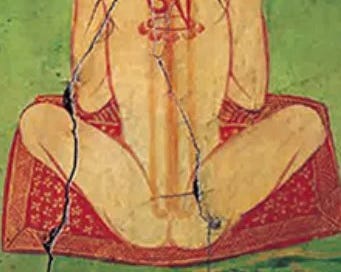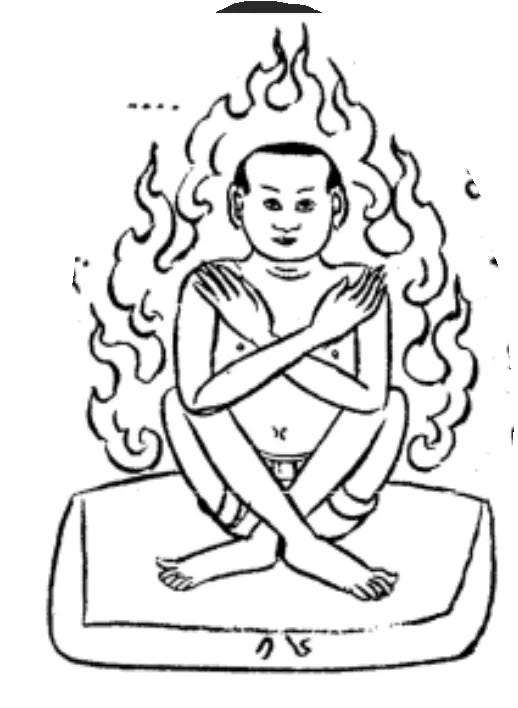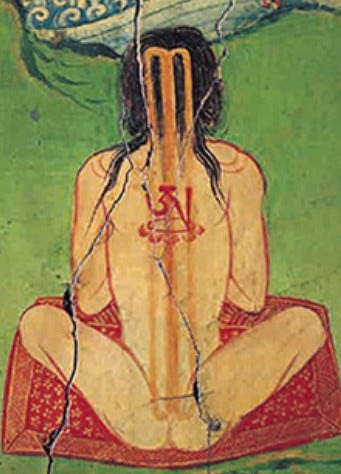Introduction
In the Sakya Lamdre tradition there are nine Caṇḍālī or Tummo practices. Five practices which do not rely on the nāḍī chakras are: 1. Feeding the fire. 2. Brahma's thunderbolt. 3. Nāḍī Yoga. 4. Fire Drill/Fireboard. 5. Bindu Yoga. Three practices relying on nāḍī Chakra are: 6. Relying on one chakra. 7. Relying on two chakras. 8. Relying on four chakras. And one practice: 9. That relies on the pith instruction. This article contains the translation of the first five caṇḍālī/Tummo practices, which do not require visualisation of the nāḍī chakras.
There are only two postures required for these practices, sitting in either a squatting or a crossed-legged position. When sitting cross-legged, there are five key body positions to bear in mind: legs crossed, hands below the navel in dhyana mudra, settling eyes on the tip of the nose, joining tongue to the palate, and keeping the spine straight. Regarding the squatting posture: Place both feet and buttocks on the ground like a tripod fireplace [with your knees upright and your legs crossed at the ankles]. Place them evenly, if they lean to one side they won't be stable. Use your arms as a yoga strap [strapping your knees with your joined arms]. Keep your spine straight with your neck slightly bent. This posture is generally used at night and to generate heat in cold weather. During the day, vajra crossed legs is commonly used.
There are several different texts on this practice, each with slightly different instructions. In this article I have referred to two texts. One is attributed to Sachen Kunga Nyingpo [11th-12th century] and the other is from the Sakya Lamdre text.
Five caṇḍālī/Tummo Practice not based on the Nāḍī-Chakras
I. Feeding the Fire (མར་མེ་གསོ་བ་)
Why is it called ‘Feeding the fire/flame of butter lamp?
Since the amrita from [the navel syllable] ཨཾ་ [aṃ] nourishes the fire of the vital air [below the navel], it is called feeding the fire of the butter lamp.
Key body posture
Sit in a squatting position: Place both feet and buttocks on the ground like a tripod fireplace [with your knees upright and your legs crossed at the ankles]. Place them evenly, if they lean to one side they won't be stable. Use your arms as a yoga strap [strapping your knees with your joined arms]. Keep your spine straight with your neck slightly bent. Overall, the posture should be comfortable.
Key points of visualisation
Visualise blue air in the shape of a bow at the anus, a red fire of wisdom at the crossroads [where the three channels meet], a dark red syllable ཀྵ་ [ksha] facing downwards four fingers below the navel, and a light red syllable ཨཾ་ [aṃ] facing upwards at the navel.
Key breathing technique
First draw the lower air up by squeezing and releasing the anal sphincter three times and holding it at the end. Then draw the upper air through the nostrils and bring it down inside. Press the chin down on the larynx, swallow some saliva without making a sound, and press the upper air down.
Making and feeding the fire:
ཀྵ་ [ksha four fingers below the navel] and ཨཾ་ [aṃ at the navel] are joined by the central channel. The lower ends of the right and left channels remain intertwined and cover the mouth of the central channel. The vital air moving through the left channel [called gnyid-ma གཉིད་མ་] generates non-conceptual wisdom, and that moving through the right channel [called me-ma མེ་མ་] generates heat. When you tighten and loosen the anal sphincter three times, these two airs meet, causing the fire of wisdom to burn at the junction of the three channels, and this makes the fire of the syllable ཀྵ་ [ksha] blaze more strongly. When the fire of the syllable ཀྵ་ [ksha] touches the ཨཾ་ [aṃ], a very fine stream of amrtia flows down in a drop from the ཨཾ་ [aṃ], which feeds the syllable ཀྵ་ [ksha] like oil poured on the wick of a butter lamp. Focus your mind on the continuous blazing of the fire and the dripping of amrita. While doing this, hold the union of the upper and lower air as long as you can.
II. Brahma’s Thunderbolt
Why this practice is called ‘Brahma’s Thunderbolt’?
As [it is believed that] Brahma exists from the beginning of the universe, the fire at the junction of the three channels is called Brahma, because this fire is also present in our body from the beginning of our birth. And as the arrow of fire at the navel is fast and powerful like a thunderbolt, and brings yogic experience swiftly, it is called a thunderbolt.
རླུང་གི་གཞུ་ལ་མེ་ཡི་མདའ། །བྱང་སེམས་ཧཾ་གི་འབེན་ལ་བརྡེག །མྱུར་དུ་་་ཡེ་ཤེས་འཆར་བར་འགྱུར།
By hitting the target ཧཾ [Haṃ] in the crown of the head with the bow of the lower air and the arrow of fire at the navel, primordial wisdom quickly arises.
The bow of lower air
The shape of the lower air is the shape of the buttocks and legs when sitting with the legs crossed. It has the shape of a bow from behind.
The arrow of fire
Triangular fire of wisdom pointing downwards is the arrowhead.
Drawing the bow and hitting the target ཧཾ [Haṃ]
Grasp the knees with both hands and lift the shoulders. Fix the belly to the spine, with the eyes wide open, roll the eyes upwards [the arrowhead of the fire pointing downwards is turned upwards]. Then, as you raise the torso with vigour, as if you were drawing the bow violently, the fire will go up through the central channel. And as you lower the torso, the fire will zigzag and hit the ཧཾ [Haṃ] at the crown of the head. This will melt the bindu. And a stream of white bodhicitta bindu flows down and spreads throughout the body, bringing bliss. That is why it is called hitting the target ཧཾ [Haṃ].
III. Nāḍī yoga [རྩའི་རྣལ་འབྱོར]
Visualisation of three channels and breathing practice
As you breathe out, visualise the red right sun channel, whose essence is fire, from the perineum to the navel, from the navel to the chest, from the chest to the throat, and from the throat to the crown of the head. As you inhale, visualise the white moon channel, whose essence is water, from the crown to the throat, from the throat to the chest, from the chest to the navel, and from the navel to the perineum. The thickness of both channels is medium reed. As the breath stays in, visualise the central channel endowed with four characteristics, which is as fine as lotus fibre, as straight as plantain tree, as red as lac dye, and as bright as sesame oil lamp. When you practise this breathing technique of the air going out, coming in and staying in, and the visualisation of the right, left and central channels as explained before, it is not certain where the mind might cease. It may occur in the right channel or the left channel or the central channel. This gives rise to yogic experiences such as the fifteen yogic experiences.
IV. Fire drill/Fire-board wheel [གཙུབ་ཤིང་ངམ་གཙུབ་སྟན་གྱི་འཁོར་ལོ་]
Posture
Sit either in a cross-legged position or in a squatting position.
Visualisation
Visualise the central channel from the navel to the top of the head. Visualise it as a fire drill [fire stick], red in colour, its thickness whatever is easier for you to visualise. Visualise the right and left channels from the navel to the top of the head as a churning rope, white in colour, its thickness whatever is easier for you to visualise. As a fireboard, visualise a drop [bindu] of blood the size of a chickpea below where the three channels meet. The a-thung which is the tip of the lower end of the central channel is inserted into the fireboard and the fire drill [the central channel] is rotated.
Breathing technique and making fire
Draw the lower air up and unite the upper and lower air. Now visualise the right and left channels as if your hands or rope were rubbing/rotating the fire-stick, which is the central channel, on the fireboard, which is the bindu of the blood, creating fire.
V. Bindu yoga [ཐིག་་ལེའི་རྣལ་འབྱོར་]
Bindu yoga comprises of four practices:
1. Union of sun and moon at the chest
Sit in a squatting position. Visualise a sphere of the moon about the size of your fingernail in your chest and a sphere of the sun about the same size on top of it. Then visualise a white bindu the size of a mustard seed between the union of the sun and the moon, having a form of clarity, mystical experience of bliss, and its true nature being a union of bliss and emptiness.
Then visualise a sound similar to the [ringing] sound of a finger tapping on a brass bell or bowl coming from the white bindu. This makes a very small hole in the sphere of the sun, the size of a horse's tail, above the white bindu. Now the object of observation is to focus the mind [as if looking] down through the hole in the sun on the white bindu. The breathing technique is to fill in the air either through the left nostril by closing the right nostril or through the mouth without sound. Then visualise the air passing through the hole in the sun and dissolving into the bindu. This brings bliss, clarity and non-conceptuality.
2. Navel’s Ekavira [bindu] (ལྟེ་བའི་དཔའ་བོ་འབའ་ཞིག་)
Posture: Sit with legs crossed. Visualisation: Visualise a sphere of moon and a clear bindu the size of a chickpea at the navel. Breathing technique: Fill in the air using one of the two methods of the 'filling up breathing technique'. Push the air down with force so that the air sinks into the bindu. Practise again and again with the mind completely focused on the bindu. This will give rise to the yogic experience of warmth at the navel. As you practise again and again, five experiential signs will arise, especially the deep non-conceptual state of mind.
3. Perineum’s blissful bindu [གསང་གནས་བདེ་བའི་ཐིག་ལེ་]
Posture: Sit in a squatting position. Visualisation: Visualise a bindu the size of a chickpea inside the vajra gem [penis, for women in རྩ་མཛེས་པའི་སྤྱི་བོར་], which is red in colour and has an aspect of luminosity and the nature of union [of bliss and emptiness]. Breathing technique: By closing and opening the anal sphincter, draw up the lower air and visualise the air sink into the bindu. This is a key technique to create supreme bliss, especially in the perineum region.
4. The seed of white hair [སྐྲ་དཀར་ས་བོན་]
Posture: Sit either in a squatting position or cross-legged. Visualisation: Visualise a crooked bindu ཧཾ [Haṃ] with the head turned inwards at the spot between the eyebrows. Breathing technique: As the air of the sun/right channel goes out [exhalation], through the power of the mind draw the air upwards through the Roma, the right channel, and visualise the air travelling upwards behind the small tongue and touching the bindu ཧཾ [Haṃ]. As a result, when the air comes in [inhaled] through the left channel, visualise a stream of white bodhicitta bindu flowing down from the ཧཾ [Haṃ] through the root of the small tongue. It first fills the throat and then spreads throughout the body, bringing bliss, warmth and samadhi. This helps the growth of the body, the clarity of the five senses, and stops grey hair and wrinkles.











